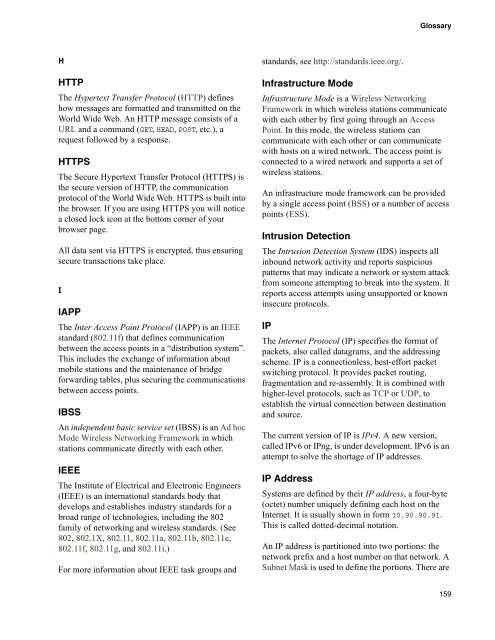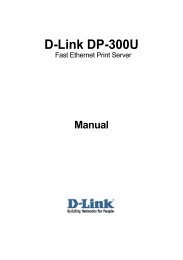Unified Access Point (AP) Administrator's Guide
Unified Access Point (AP) Administrator's Guide
Unified Access Point (AP) Administrator's Guide
You also want an ePaper? Increase the reach of your titles
YUMPU automatically turns print PDFs into web optimized ePapers that Google loves.
H<br />
HTTP<br />
The Hypertext Transfer Protocol (HTTP) defines<br />
how messages are formatted and transmitted on the<br />
World Wide Web. An HTTP message consists of a<br />
URL and a command (GET, HEAD, POST, etc.), a<br />
request followed by a response.<br />
HTTPS<br />
The Secure Hypertext Transfer Protocol (HTTPS) is<br />
the secure version of HTTP, the communication<br />
protocol of the World Wide Web. HTTPS is built into<br />
the browser. If you are using HTTPS you will notice<br />
a closed lock icon at the bottom corner of your<br />
browser page.<br />
All data sent via HTTPS is encrypted, thus ensuring<br />
secure transactions take place.<br />
I<br />
I<strong>AP</strong>P<br />
The Inter <strong>Access</strong> <strong>Point</strong> Protocol (I<strong>AP</strong>P) is an IEEE<br />
standard (802.11f) that defines communication<br />
between the access points in a “distribution system”.<br />
This includes the exchange of information about<br />
mobile stations and the maintenance of bridge<br />
forwarding tables, plus securing the communications<br />
between access points.<br />
IBSS<br />
An independent basic service set (IBSS) is an Ad hoc<br />
Mode Wireless Networking Framework in which<br />
stations communicate directly with each other.<br />
IEEE<br />
The Institute of Electrical and Electronic Engineers<br />
(IEEE) is an international standards body that<br />
develops and establishes industry standards for a<br />
broad range of technologies, including the 802<br />
family of networking and wireless standards. (See<br />
802, 802.1X, 802.11, 802.11a, 802.11b, 802.11e,<br />
802.11f, 802.11g, and 802.11i.)<br />
For more information about IEEE task groups and<br />
standards, see http://standards.ieee.org/.<br />
Infrastructure Mode<br />
Glossary<br />
Infrastructure Mode is a Wireless Networking<br />
Framework in which wireless stations communicate<br />
with each other by first going through an <strong>Access</strong><br />
<strong>Point</strong>. In this mode, the wireless stations can<br />
communicate with each other or can communicate<br />
with hosts on a wired network. The access point is<br />
connected to a wired network and supports a set of<br />
wireless stations.<br />
An infrastructure mode framework can be provided<br />
by a single access point (BSS) or a number of access<br />
points (ESS).<br />
Intrusion Detection<br />
The Intrusion Detection System (IDS) inspects all<br />
inbound network activity and reports suspicious<br />
patterns that may indicate a network or system attack<br />
from someone attempting to break into the system. It<br />
reports access attempts using unsupported or known<br />
insecure protocols.<br />
IP<br />
The Internet Protocol (IP) specifies the format of<br />
packets, also called datagrams, and the addressing<br />
scheme. IP is a connectionless, best-effort packet<br />
switching protocol. It provides packet routing,<br />
fragmentation and re-assembly. It is combined with<br />
higher-level protocols, such as TCP or UDP, to<br />
establish the virtual connection between destination<br />
and source.<br />
The current version of IP is IPv4. A new version,<br />
called IPv6 or IPng, is under development. IPv6 is an<br />
attempt to solve the shortage of IP addresses.<br />
IP Address<br />
Systems are defined by their IP address, a four-byte<br />
(octet) number uniquely defining each host on the<br />
Internet. It is usually shown in form 10.90.90.91.<br />
This is called dotted-decimal notation.<br />
An IP address is partitioned into two portions: the<br />
network prefix and a host number on that network. A<br />
Subnet Mask is used to define the portions. There are<br />
159
















